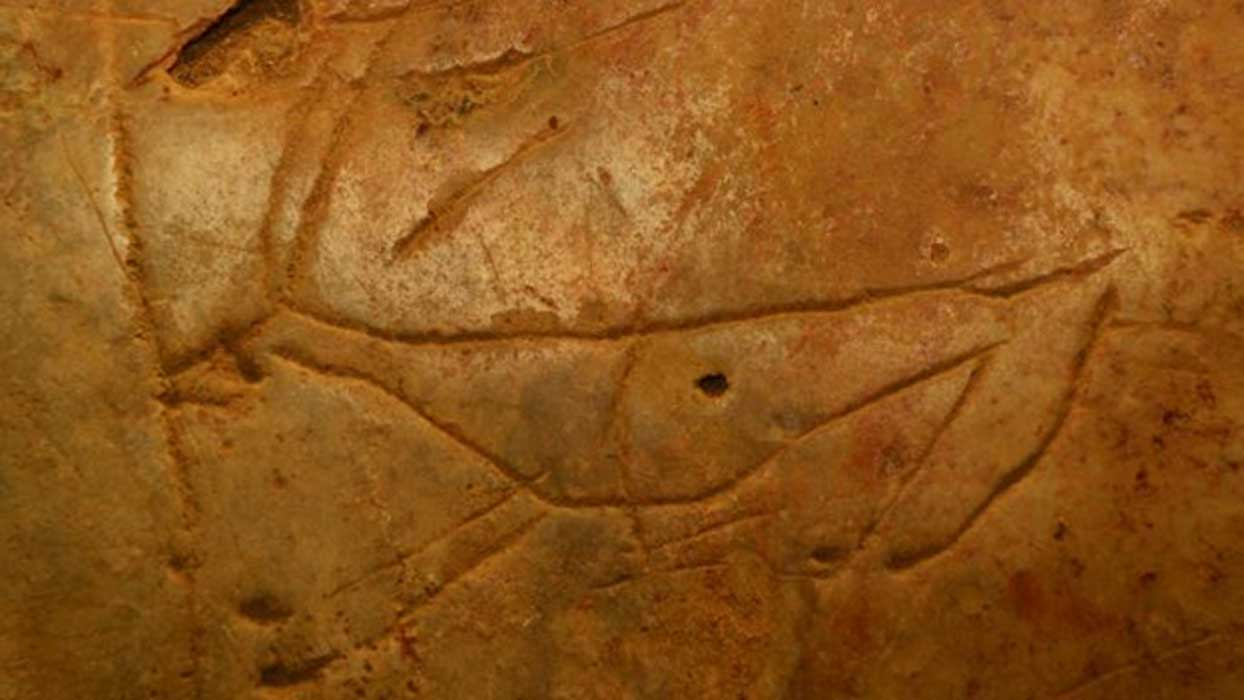Greek Art Goes Palaeolithic: Cretan Cave Art Includes an Animal Extinct for 11,000 Years
More than 11,000 years ago, an Ice Age artist carefully carved the images of deer into the floor of a cave on Crete. Others would follow this person’s lead and soon the engravings became a jumble of drawings. It is only now, thanks to advancements in the technology available to archaeologists, that the first elements of the Ice Age cave art can been seen by modern eyes.
The Times reports researchers have known about the art in Asphendou Cave, in western Crete, for decades. But it is only through technological advancement that the overlapping engravings can be dated accurately.
![]()
A quadruped with paddle shaped icons engraved across the torso. (S. Murray)
When the deer cave art was first noted by archaeologists they thought the animal shown in the drawings was a feral goat. The date they gave the images initially was the Bronze Age. Both of these early assumptions have now been discarded. Instead, the authors write the animal is an endemic dwarf deer called Candiacervus ropalophorus, which went extinct over 11,000 years ago. That means the Asphendou Cave petroglyphs were made during the Late Pleistocene or Upper Palaeolithic period.
- Did Humans Speak Through Cave Art? Ancient Drawings and Language's Origins
- Shamanic Explorations of Supernatural Realms: Cave Art - The Earliest Folklore

The extinct endemic deer of Crete ( Candiacervus). Several types of antlers are recognized ranging from long unbranched beams to short multi‑tined antlers. (G. Lyras, S. Murray and A. van der Geer)
Dr Thomas Strasser of Providence College, Rhode Island says,
“This is the first Palaeolithic art ever found in Greece. It’s significant because it deepens the history of art there by many thousands of years, and is like an eyewitness account of Ice Age Crete. Archaeological and palaeontological information, as well as new technologies unavailable to earlier scholars, offer evidence to confirm a Palaeolithic date for the earliest carvings.”
According to Greek Reporter, the type of deer shown in the 37 images has long antlers and short lateral tines (branches or forks in the antlers). These animals used to live on the north coast of Crete between 21,500 to 11,000 years ago.
Why did the artist carve images of deer into the cave floor? The researchers’ report on their findings provides a suggestion for the image choice and also the significance of the discovery,
“Unsurprisingly, Palaeolithic artists represented what they knew, in this case a prevalent species of Cretan dwarf deer ( Candiacervus), which became extinct in the Upper Palaeolithic. Comparable early artistic expressions are not known from the Aegean basin. Our study of the Asphendou petroglyphs therefore deepens scholarly understanding of early hominins' capacities for imaginative projection and confirms the precocity of Palaeolithic seafarers in the Mediterranean.”

Above: An image, generated from a high-resolution 3D model, showing the range of relief or depth in the carving of cupules, antlers, and other scratches in the Asphendou Cave surface. Below: A gray-scale depth map of the Asphendou Cave petroglyphs. (S. Murray and P. Sapirstein)
To identify the animal, the researchers write they used photogrammetry (Structure-from-Motion technology) to record and pick apart the petroglyphs. They then compared the animal to previously excavated Candiacervus remains found in the Liko and Gerani Caves and housed in the Museum of Paleontology and Geology of the National and Kapodistrian University of Athens, Greece.
They declare that the deer depicted in the cave art “should be dated to the Palaeolithic period, making it the earliest figural art not only on Crete, but also in Greece. Until now, the earliest figural art known from Greece is dated to the Neolithic period (ca. 8,5 to 5 thousand years ago).”
Apart from the deer, the team also identified more cave art. They spotted what they call “‘boat(s)’ and a ‘starburst’”, a series of cupules arranged in geometric patterns, paddle-shaped motifs and bow and arrow motifs.

Left: The boat engraving near the back of the cave. Right: the starburst, cupules, and quadrupeds. (S. Murray)
Finally, the researchers suggest that the new information can aid paleontologists and archaeologists interested in questions of “resource exploitation, environmental impact and symbolic behavior on Crete” in the Ice Age.
The results of the study are published in the Journal of Archaeological Science: Reports.
Top Image: A carving of an extinct deer in the Asphendou Cave on Crete. Source: Sarah Murray


















Comments
It can not be Greek's, they come much later on these spaces
The DNA suggests a colonisation of Crete from another island, what is the dating based upon?